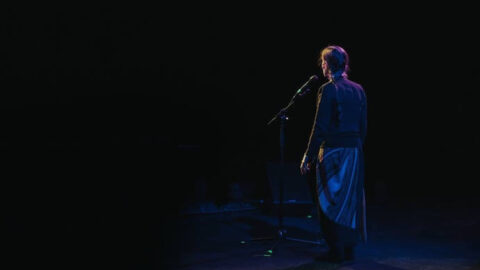The 2017 Big Ears Festival continued its eclectic programming on March 25-26 with performances by Meredith Monk, the Theo Bleckmann Quintet, The Magnetic Fields, Yasmine Hamdan, Deerhoof, and the Gavin Bryars Ensemble. I had never heard Meredith Monk perform, but that changed on Saturday, March 25th at the Bijou Theatre. Monk’s music is meditative, like water bubbling from a stream. The flow was constant, both serene and active. This was especially apparent during the spellbinding Click Song #2. Elsewhere hypnotic counterpoint emerged when Monk was joined by members of her vocal ensemble. The entire concert experience was akin to listening to a lullaby in a foreign language–what was once unfamiliar soon became comforting.
The vocal mysticism at the Bijou continued when the Theo Bleckmann Quintet took the stage later in the afternoon. If I’ve ever heard vocal timbre without impurities, Bleckmann’s is as close as it gets. The singer’s signature straight tone was ever-present, whether in a warm, rounded lower range or in his cool, blue falsetto. With incredibly atmospheric accompaniment, the quintet lent a New Age aura to Bleckmann’s vocal jazz aesthetic.

The rest of the day was dominated by artists with a decidedly pop music flair. First was The Magnetic Fields led by its prodigious songwriter and frontman Stephin Merritt. At the Tennessee Theatre, the band presented the first half of its latest epic effort, the “50 Song Memoir. ” The performance was buttressed with a quaint stage presentation that found Merritt set against the backdrop of a child’s room–replete with mini-playhouses and various instruments and noisemakers he would later use in the set–as well as music videos that were projected high above the band during each song, providing visual context. Merritt is an undeniably gifted at his craft; here, he wove an extended autobiographical tale that tinged in humor even in its deadpan delivery. The whole affair was its most charming when it sounded most like an exaggerated yarn, as in songs like “ ‘68: A Cat Called Dionysus” and “ ‘74: No.”
Lebanese singer-songwriter Yasmine Hamdan–who made a notable cameo in Jim Jarmusch’s 2013 vampire flick “Only Lovers Left Alive”–wowed the audience with her alluring voice and sultry stage presence at The Standard. Hamdan possesses a soaring voice, and she utilized it to great effect amidst propulsive percussion, spiky, distorted lead guitar, and moody keyboard drones. The songs were, at their cores, pure pop, but they were imbued with plenty of sophistication and developing intrigue to maintain the interest of the most discerning musical tastes. The inimitable experimental rock band Deerhoof closed out the evening at The Mill & Mine. Irrepressibly energetic, the quartet playfully powered their way through songs like “Twin Killers” and “Fresh Born.” No one pounds those drums quite like Greg Saunier, and aided by dual guitar threat of John Dieterich and Ed Rodriguez, bassist/vocalist Satomi Matsuzaki led the group through what was a raucous and endearing set.

The biggest letdown of the festival for me was surprising: the closing headliner Gavin Bryars Ensemble, conducted by Bryars, performing his The Sinking of the Titanic. It was a momentous evening, marking the first performance of the work in the United States, accompanied here by wonderful archival film footage. The composition took its time, moving at an exquisitely tender, even glacial pace. The texture of the strings matched this approach with a delicacy and reverence. This “sinking” was not cataclysmic, but instead seemed to invite the listener to witness the great, doomed ship just after the initial impact. What the audience was left with was like watching the vessel slowly submerged beneath the icy waters, and with it the lives of the passengers, their frail humanity, and the intricacies of their individual stories. And yet, for all the intrinsic beauty and substance of the work, I wasn’t moved. Perhaps this was some peculiar moral failing on my part, maybe I would have been more attuned to it if I had heard it earlier on in the festival. In short, The Sinking of the Titanic felt anticlimactic as one of the festival’s final performances.
























